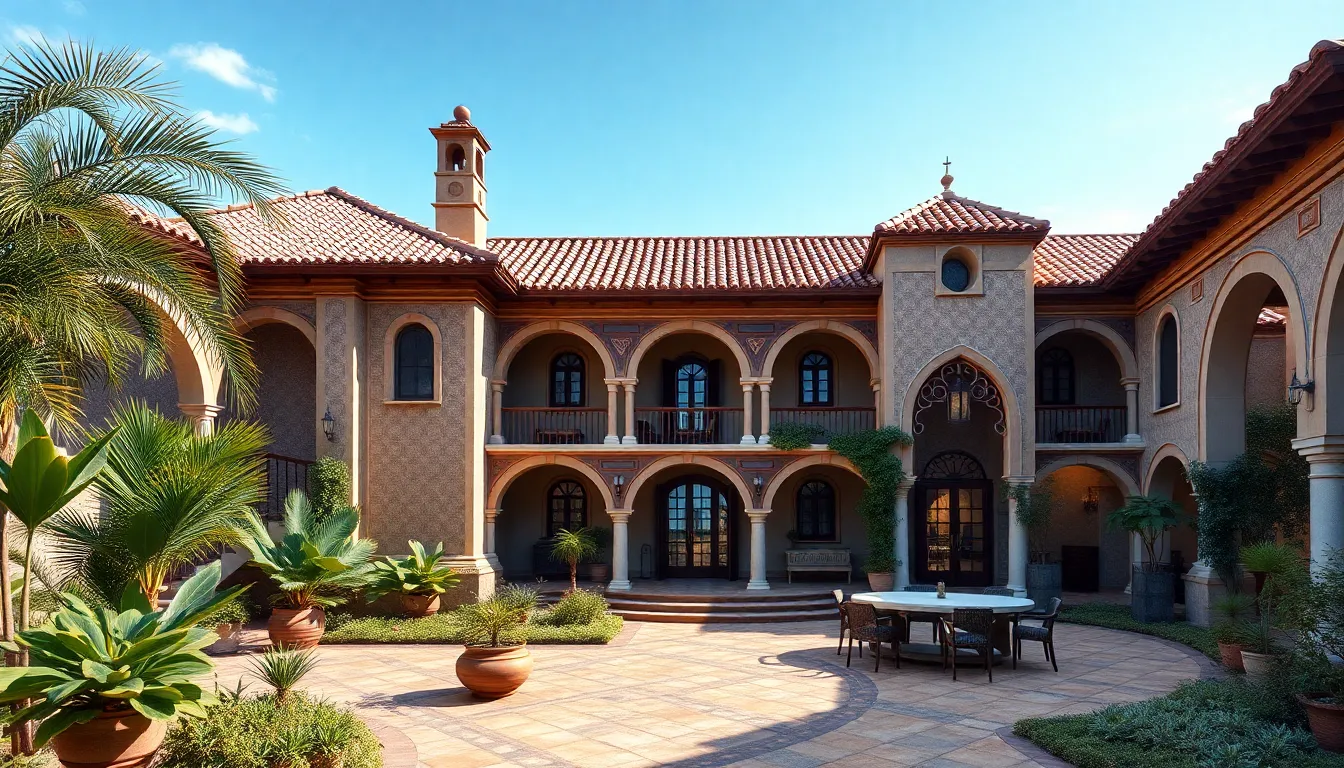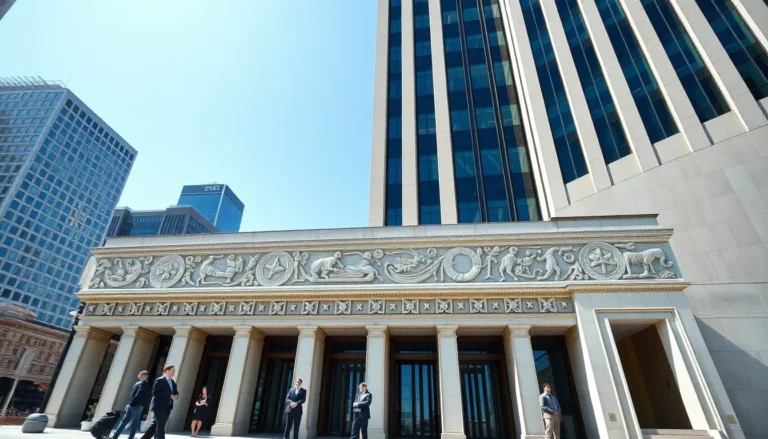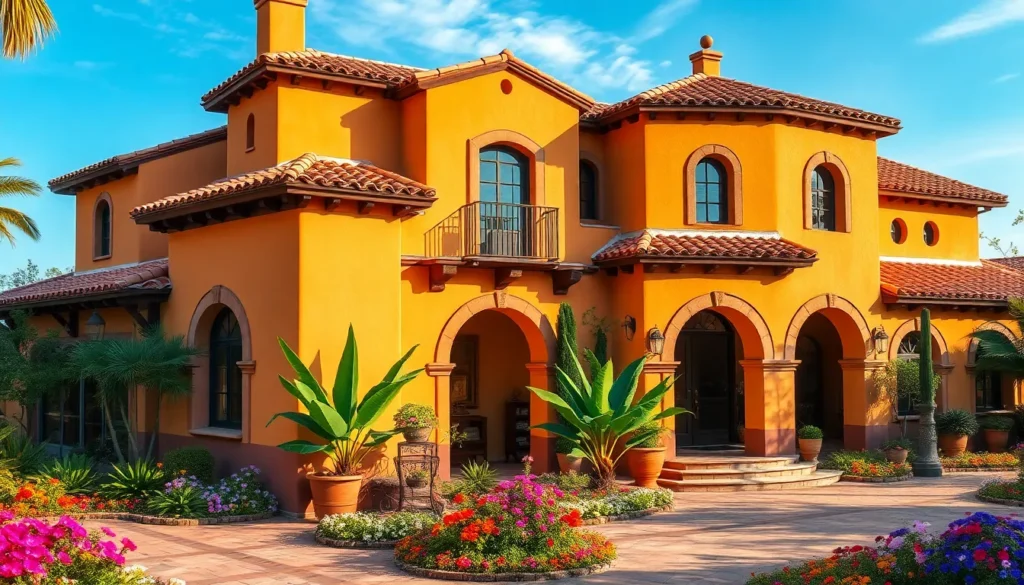Table of Contents
ToggleSpanish architecture houses are like a fiesta for the eyes, blending vibrant colors and intricate details that make even the most mundane neighborhood feel like a sun-soaked vacation. Imagine stepping into a world where every tile tells a story and every arch invites you to explore. These homes aren’t just structures; they’re a celebration of culture, history, and a dash of flair that even your most stylish friend would envy.
From the charming courtyards to the bold stucco exteriors, Spanish architecture captures the essence of warmth and hospitality. Whether you’re dreaming of a cozy abode or just looking to jazz up your Pinterest board, these houses offer inspiration that’ll make you want to pack your bags and move to sunny Spain—sangria in hand, of course! Dive into the enchanting world of Spanish architectural design, where every corner is a canvas waiting to be admired.
Overview of Spanish Architecture House
Spanish architecture houses showcase a unique blend of cultural influences, making them distinct and inviting. Combining Moorish, Roman, and Mediterranean styles, these homes often feature tile roofs, arched doorways, and intricate ironwork. Bright colors enhance their exteriors, while lush gardens and vibrant courtyards create serene outdoor spaces.
Warm tones characterize the stucco walls, which not only offer aesthetic appeal but also provide insulation against heat. Many homes include outdoor living areas that promote social gatherings and interaction. Elements like tiled patios and fire pits serve as common focal points, encouraging alfresco dining and relaxation.
Inside these homes, expect to find open floor plans that maximize space and light. Traditional Spanish interiors often include terracotta floors, wooden beams, and handcrafted tiles. Decorative features such as vaulted ceilings and ornate fireplaces add charm and elegance to living spaces.
The cultural significance of Spanish architecture extends beyond mere aesthetics. Each design element reflects the country’s rich history and warm hospitality. Architects carefully consider local materials, climate, and landscape when designing these homes, ensuring they harmonize with their surroundings.
Many recent trends in Spanish architecture focus on sustainability and modern convenience. Eco-friendly materials and energy-efficient technologies complement traditional designs. This fusion of old and new not only preserves heritage but also addresses current environmental concerns.
Spanish architecture remains timeless and relevant, capturing the hearts of those who seek both beauty and functionality in their homes. Embracing this architectural style invites a lifestyle filled with warmth, community, and lasting memories.
Historical Significance

Spanish architecture carries a rich historical significance that reflects its diverse cultural heritage. This style showcases the evolution of various influences over centuries.
Origins of Spanish Architecture
Origins trace back to the Iberian Peninsula, where early structures featured simple designs. Roman construction techniques introduced the use of arches and vaults, setting the foundation for future development. Moorish influences are evident in the intricate tilework and ornamental details, a legacy from the Islamic Golden Age. Renaissance elements later emerged, emphasizing symmetry and grandeur, enriching the architectural narrative.
Influences on Design
Influences on design stem from a mix of cultures, prominently including Moorish, Roman, and Gothic styles. Each culture contributed unique characteristics, such as the iconic horseshoe arches from the Moors and the ornate facades seen in Gothic churches. Mediterranean climate also played a role, encouraging outdoor living spaces that blend seamlessly with the landscape. Spanish architecture embodies adaptability, effectively responding to climate and local materials for durability and beauty.
Key Features of Spanish Architecture House
Spanish architecture houses stand out for their distinctive and inviting characteristics, enhancing their cultural significance.
Material Usage
Natural materials play a crucial role in Spanish architecture. Stucco exteriors provide aesthetic appeal, insulate against heat, and resist humidity. Roofs often feature ceramic tiles, adding functionality and color. Stone and adobe are common in construction, reflecting the local environment. Wood beams, frequently exposed, add warmth and character to interiors. Ironwork details contribute to visual charm while ensuring durability. These materials blend seamlessly, creating a cohesive design that showcases a deep respect for local traditions.
Architectural Styles
Diverse influences shape the architectural styles of Spanish houses. Moorish design elements manifest in intricate tilework and arched doorways, reflecting historical significance. Roman contributions introduce symmetry through column structures, complementing the overall aesthetic. Mediterranean designs emphasize open spaces, incorporating courtyards that invite outdoor living. Contemporary Spanish architecture increasingly integrates sustainable practices, utilizing eco-friendly materials and energy-efficient technologies. This fusion of styles creates unique homes that preserve tradition while embracing modernity, appealing to a wide range of homeowners.
Notable Spanish Architecture Houses
Spanish architecture showcases numerous remarkable houses that embody the nation’s rich cultural heritage. These structures exhibit unique designs and historical significance, capturing the essence of Spain’s architectural evolution.
Casa Batlló
Casa Batlló stands out as a masterpiece by architect Antoni Gaudí. Located in Barcelona, this building features an undulating facade adorned with colorful ceramic tiles and flowing forms. Known for its organic shapes, the design mimics natural elements. Gaudí incorporated intricate details like arched windows and a magical rooftop resembling a dragon’s back. The interior boasts open, airy spaces filled with light, showcasing Gaudí’s innovative use of materials. Visitors admire the museum’s immersive experience, which reflects Gaudí’s vision of harmony between architecture and nature.
Alhambra Palace
Alhambra Palace, an iconic fortress complex in Granada, exemplifies Moorish architecture’s grandeur. Built in the 13th century, it showcases intricate stucco work, graceful arches, and serene courtyards. Crystal-clear fountains enhance the tranquil ambiance in the gardens surrounding the palace. The palace features stunning tile mosaics, which tell stories of the era’s artistic mastery. Architectural elements blend with lush landscapes, creating a harmonious retreat. Visitors marvel at the breathtaking views of the Sierra Nevada mountains from the palace’s terraces. Alhambra serves as a testament to Spain’s historical influences and architectural brilliance.
Contemporary Trends in Spanish Architecture
Contemporary Spanish architecture highlights innovation alongside tradition, reflecting modern lifestyles while honoring historical roots.
Modern Interpretations
Modern interpretations of Spanish architecture showcase innovative designs that blend traditional elements with contemporary aesthetics. Architects experiment with open layouts, emphasizing natural light and fluid spaces that adapt to multifunctional living. While retaining features like decorative tiles and arched doorways, they incorporate sleek lines and minimalist decor. Such designs facilitate a seamless indoor-outdoor flow, enhancing the connection with nature. Notable examples include residential projects that embrace larger windows and green roofs, showcasing the evolution of Spanish architectural style while maintaining cultural significance.
Sustainable Practices
Sustainable practices increasingly define contemporary Spanish architecture, aligning with global eco-consciousness. This trend incorporates locally sourced materials like adobe, stone, and reclaimed wood, reducing environmental impact. Architects integrate energy-efficient technologies, such as solar panels and advanced insulation, promoting reduced energy consumption. Green spaces become central features, including rooftop gardens and native landscaping, enhancing biodiversity and promoting well-being. The emphasis on sustainability reinforces a commitment to preserving the cultural and environmental heritage of Spain, ensuring that future generations inherit a balanced and beautiful living environment.
Spanish architecture captivates with its rich history and vibrant aesthetics. The blend of cultural influences creates homes that are not only beautiful but also functional and inviting. These structures foster a sense of community and warmth, making them ideal for modern living.
As sustainability becomes increasingly important, contemporary Spanish designs are evolving while respecting traditional elements. By incorporating eco-friendly materials and energy-efficient technologies, they honor the past while looking toward the future.
Embracing Spanish architectural style can inspire a lifestyle filled with beauty and connection, allowing individuals to enjoy the charm and character that these homes effortlessly provide.







